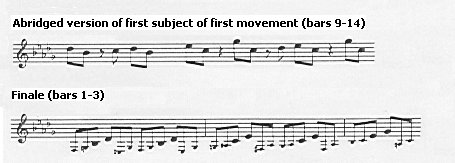both themes follow the same pattern, as shown
in Example 20. Furthermore, the ensuing parts exhibit characteristics of motif
II, as illustrated in Example 21:
Example 20:
Similarity between the first subject of the first movement and the
first four bars of the
Finale

Example 21: Motif
II as it appears in bars 5 and 7 in the Finale

Réti even manages to find hints of a true cantilena as the
second theme in a movement characterised by fast, continuous triplet quavers.
The idea of such a melodious theme is evident in the second section of the
Finale (bars 23-30), exactly when it is due, through figurations shown in
Example 22: